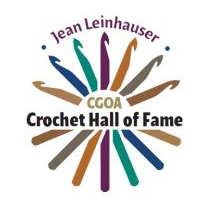Ross 1878 patented crochet needles
By 1868 crochet needles in the U.S. were being made from tempered steel wire – not wrought iron that was converted to steel after the needle was formed as needles were in the 1840s and 1850s. But the new Bessemer method of steel making was still in its infancy as was development of tools to fashion the steel. Swaging or stamping, the method used to fashion steel hooks today, was not yet possible.
During this time two different designs for steel hooks were used. Both had manufacturing drawbacks. In one method, a needle was mounted in a handle. The handles were made from a variety of materials: bone, wood, brass, steel wire and steel sheet were common. Having separate handles made and attaching them to the needles was labor intensive. In the other method, a steel rod was tapered by being drawn out at one end and formed into a hook. Drawing steel caused it to loose its temper and the needle had to be heated and tempered a second time. William Ross patented a crochet needle that he thought would overcome the drawbacks of these two types of hooks.
William Ross of Baltimore, Maryland, patented a method of attaching a handle to a crochet needle on May 27, 1879 (U.S. patent no. 215,979). Of the early U.S. patents related to crochet needles, this is the oldest one that I know an actual hook exists. The following excerpts are from the patent.
“ it consists of a crochet needle having a tempered hooked stem provided with a handle formed by casting a readily fusible metal on one end of said stem … The handle, is formed by placing the stem in a mold and pouring the fused metal around it”. The handle was made of a soft, low melting temperature metal such as pewter.
“One special advantage in construction crochet needles as herein described consists in the fact that the stem may be formed of tempered steel of a uniform thickness or gage … In wholly metallic needles heretofore constructed, the handle has invariably been of the same metal as the stem, and where steel was used the stems, after being reduced to the required size, had to be tempered before the needles were fit for use.”
“By casting a very fusible metal around an end of the tempered stem to form the handle two results are attained, the first being that the temper of the stem is not affected by the low temperature requisite to fuse the metal and form a handle; and, secondly, the soft metal forming the handle can more readily be impressed with the numbers of the needles than when a hard metal is employed.”
Ross crochet needles were produced with a variety of handle designs and with either one or two needles. The handles were usually clearly stamped with W. ROSS’S PAT. 79, PAT. May ’79 or a similar mark. You can’t miss them.


